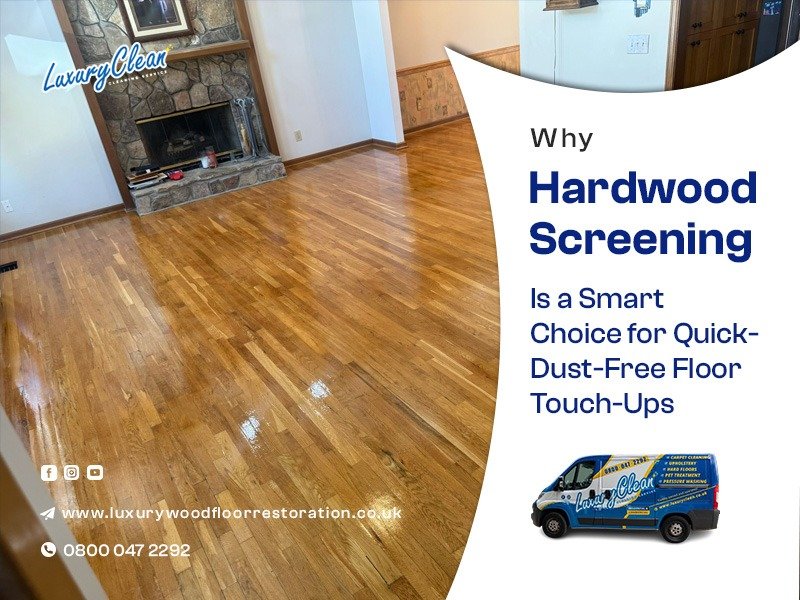Ever stared at pale scuff marks by your front door and thought, ‘Is a full refinishing my only option?’ Traditional hardwood sanding in London piles up dust and drags on for days. A 2024 London Homeowner Report found that a large percentage of flats suffer scratches within a year. Screening eases that hassle by refreshing only the topcoat in under an afternoon; it’s a quick, tidy solution.
Benefits of hardwood screening
Hardwood screening revives minor wear without stripping your finish. In London, winter damp warps boards, and Notting Hill Carnival prep adds foot traffic, so low‑dust options matter. It lightly scuffs the topcoat to blend scratches. “Screening’s minimal mess makes it ideal on central London terraces,” says Tom Bradshaw, a Mayfair floor restorer.
These benefits showcase how screening fits perfectly into London homes:
- Minimal Disruption: You keep furniture in place, so daily life carries on without a hitch
- Dust Reduction: Fine particles stick to the abrasive pad, slashing airborne dust levels
- Finish Preservation: Topcoat scuffing retains your stain and grain, keeping your original look
Quick Dust Free Touch Ups
Need a last‑minute spruce up before guests arrive? Dust‑free touch‑ups mean you can refresh floors before hosting guests in Notting Hill or cleaning up after a Borough Market visit. Screening’s low‑dust approach fits tight Victorian terraces and alike. It requires an abrasive screen and buffer, a DIY novice can set up quickly. With screening, you finish in under two hours and resume dust‑free.
These points highlight why screening is the go-to for fast, clean updates:
- Quick Setup: You need just an abrasive screen and buffer, so you can start in minutes
- Easy Cleanup: Fine dust traps onto the abrasive pad, cutting sweep‑up time drastically
- Minimal Downtime: You finish in under two hours and carry on with your day
Comparing hardwood Sanding with Screening
Choosing between hardwood screening and sanding depends on damage severity and London flat constraints. Full sanding uses coarse grit to cut into timber and removes old finishes, but it generates heavy dust. Screening refreshes only the top layer, preserves your stain tone, and complies with local dust regulations. “Only sand if you have deep gouges; screening saves time in busy flats,” advises Jane Clarke, a Guildhall contractor.
These differences will help you pick the right method for your London home:
- Depth of Abrasion: Sanding cuts into timber layers while screening only renews the existing finish
- Dust Output: Sanding sends clouds of debris airborne, whereas screening keeps particles contained
- Project Scope: Sanding often demands restaining, but screening lets you retain your chosen shade
Tips for Wood Floor Restoration Projects
Planning a wood floor restoration project in London means accounting for local humidity swings and Victorian architecture. Aim to work in spring or early autumn when indoor moisture sits between 40 and 60 per cent, so boards settle evenly. I remember tackling my Bayswater flat last April; a sudden CAZ update derailed my finish delivery. Always choose abrasive pads suited to your existing coating—120‑grit for oil‑based, 150‑grit for water‑based. Finish off with a clear topcoat to seal out grime and foot traffic.
Follow these tips to ensure a lasting finish in your London home:
- Monitor Moisture: Keep indoor humidity at 40–60 per cent to prevent board gaps or warping
- Use Correct Abrasive: Match grit to your finish—120‑grit for oil‑based and 150‑grit for water‑based coatings
- Seal Properly: Apply a clear topcoat to protect against grime, Borough Market spills, and everyday foot traffic
Conclusion
Screening delivers fast, low‑dust updates that suit London’s busy lifestyle and varied seasons. For deeper scratches, spot‑sand carefully—but save full refinishing for major overhauls. Think about which method suits your flat, and next time you spot a scuff, pick the approach that works best for you.

